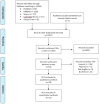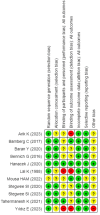Single-versus double-layer uterine closure at the time of cesarean delivery and risk of uterine scar niche: a systematic review and meta-analysis of randomized trials
- PMID: 40833607
- PMCID: PMC12414086
- DOI: 10.1007/s00404-025-08151-y
Single-versus double-layer uterine closure at the time of cesarean delivery and risk of uterine scar niche: a systematic review and meta-analysis of randomized trials
Abstract
Objective: This systematic review and meta-analysis compared single- versus double-layer uterine closure at the time of cesarean delivery.
Data sources: MEDLINE, EMBASE, Scopus, ClinicalTrials.gov, and Cochrane Central Register of Controlled Trials were searched from inception until May 2024.
Study eligibility criteria: We included only randomized controlled trials (RTSs) that compared single-layer versus double-layer uterine closure at the time of cesarean delivery.
Study appraisal and synthesis methods: Outcomes were analyzed using a random-effects model. Results are expressed as risk differences. The assessment of the risk of bias was performed by using the Risk of Bias 2 tool. The primary outcome was the incidence of scar defects (i.e., niche) at 6 months after delivery. The secondary outcomes were incidence of scar defects at 6 weeks and 3 months.
Results: A total of 18 studies were identified by the systematic review; 11 RCTs involving 6,058 participants were included in the meta-analysis. There is no statistical difference between single-layer and double-layer uterine closure of cesarean delivery incision regarding the incidence of uterine scar defect at six weeks. Single-layer closure showed a significantly lower incidence of niche after three months (RD = - 0.02 (- 0.06, 0.02); I2 = 81%, p < 0.01), and six months (RD = - 0.11, CI - 0.15, - 0.07, I2 = 91%, p < 0.01).
Conclusions: Single-layer uterine closure at the time of cesarean delivery resulted in a lower uterine scar defects after three and six months compared to double-layer uterine closure.
Systematic review registration: PROSPERO, Unique identifier: CRD42024552495.
Keywords: Cesarean; Cesarean section; Double-layer; Isthmocele; Niche; Scar defects; Single-layer; Ultrasound; Uterine closure; Uterine scar defect.
© 2025. The Author(s).
Conflict of interest statement
Declarations. Conflict of interest: The authors declare no competing interests. Ethical approval: This protocol did not require human or animal ethics approval.
Figures






References
-
- Nagy S, Papp Z (2020) Global approach of the cesarean section rates. J Perinat Med 49(1):1–4. 10.1515/jpm-2020-0463 - PubMed
-
- Otkjaer AM, Jørgensen HL, Clausen TD, Krebs L (2019) Maternal short-term complications after planned cesarean delivery without medical indication: a registry-based study. Acta Obstet Gynecol Scand 98(7):905–912. 10.1111/aogs.13549 - PubMed
-
- van der Voet LF, Bij de Vaate AM, Veersema S, Brölmann HA, Huirne JA (2014) Long-term complications of caesarean section. The niche in the scar: a prospective cohort study on niche prevalence and its relation to abnormal uterine bleeding. BJOG 121(2):236–244. 10.1111/1471-0528.12542 - PubMed
-
- Watson HA, Carter J, David AL, Seed PT, Shennan AH (2017) Full dilation cesarean section: a risk factor for recurrent second-trimester loss and preterm birth. Acta Obstet Gynecol Scand 96(9):1100–1105. 10.1111/aogs.13160 - PubMed
-
- Matsuzaki S, Mandelbaum RS, Sangara RN, McCarthy LE, Vestal NL, Klar M, Matsushima K, Amaya R, Ouzounian JG, Matsuo K (2021) Trends, characteristics, and outcomes of placenta accreta spectrum: a national study in the United States. Am J Obstet Gynecol 225(5):534.e1-534.e38. 10.1016/j.ajog.2021.04.233 - PubMed
Publication types
MeSH terms
LinkOut - more resources
Full Text Sources
Medical
Miscellaneous

